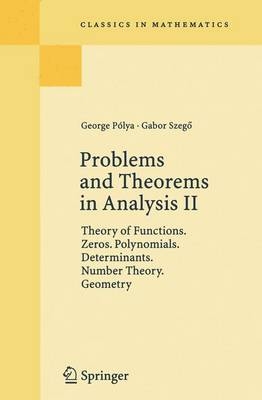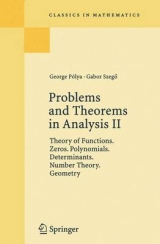Problems and Theorems in Analysis II
Springer-Verlag Berlin and Heidelberg GmbH & Co. K
978-3-540-06972-0 (ISBN)
- Titel ist leider vergriffen;
keine Neuauflage - Artikel merken
Biography of George Polya Born in Budapest, December 13, 1887, George Polya initially studied law, then languages and literature in Budapest. He came to mathematics in order to understand philosophy, but the subject of his doctorate in 1912 was in probability theory and he promptly abandoned philosophy. After a year in Gottingen and a short stay in Paris, he received an appointment at the ETH in Zurich. His research was multi-faceted, ranging from series, probability, number theory and combinatorics to astronomy and voting systems. Some of his deepest work was on entire functions. He also worked in conformal mappings, potential theory, boundary value problems, and isoperimetric problems in mathematical physics, as well as heuristics late in his career. When Polya left Europe in 1940, he first went to Brown University, then two years later to Stanford, where he remained until his death on September 7, 1985. Biography of Gabor Szego Born in Kunhegyes, Hungary, January 20, 1895, Szego studied in Budapest and Vienna, where he received his Ph. D. in 1918, after serving in the Austro-Hungarian army in the First World War. He became a privatdozent at the University of Berlin and in 1926 succeeded Knopp at the University of Ksnigsberg. It was during his time in Berlin that he and Polya collaborated on their great joint work, the Problems and Theorems in Analysis. Szego's own research concentrated on orthogonal polynomials and Toeplitz matrices. With the deteriorating situation in Germany at that time, he moved in 1934 to Washington University, St. Louis, where he remained until 1938, when he moved to Stanford. As department head at Stanford, he arranged for Polya to join the Stanford faculty in 1942. Szego remained at Stanford until his death on August 7, 1985.
Four. Functions of One Complex Variable. Special Part.- 1. Maximum Term and Central Index, Maximum Modulus and Number of Zeros.- 1 (1-40) Analogy between ?(r) and M(r), v(r) and N(r).- 2 (41-47) Further Results on ?(r) and v(r).- 3 (48-66) Connection between ?(r), v(r), M(r) and N(r).- 4 (67-76) ?(r) and M(r) under Special Regularity Assumptions.- 2. Schlicht Mappings.- 1 (77-83) Introductory Material.- 2 (84-87) Uniqueness Theorems.- 3 (88-96) Existence of the Mapping Function.- 4 (97-120) The Inner and the Outer Radius. The Normed Mapping Function.- 5 (121-135) Relations between the Mappings of Different Domains.- 6 (136-163) The Koebe Distortion Theorem and Related Topics.- 3. Miscellaneous Problems.- 1 (164-174.2) Various Propositions.- 2 (175-179) A Method of E. Landau.- 3 (180-187) Rectilinear Approach to an Essential Singularity.- 4 (188-194) Asymptotic Values of Entire Functions.- 5 (195-205) Further Applications of the Phragmen-Lindelof Method.- 6 (*206-*212) Supplementary Problems.- Five. The Location of Zeros.- 1. Rolle's Theorem and Descartes' Rule of Signs.- 1 (1-21) Zeros of Functions, Changes of Sign of Sequences.- 2 (22-27) Reversals of Sign of a Function.- 3 (28-41) First Proof of Descartes' Rule of Signs.- 4 (42-52) Applications of Descartes' Rule of Signs.- 5 (53-76) Applications of Rolle's Theorem.- 6 (77-86) Laguerre's Proof of Descartes' Rule of Signs.- 7 (87-91) What is the Basis of Descartes' Rule of Signs?.- 8 (92-100) Generalizations of Rolle's Theorem.- 2. The Geometry of the Complex Plane and the Zeros of Polynomials.- 1 (101-110) Center of Gravity of a System of Points with respect to a Point.- 2 (111-127) Center of Gravity of a Polynomial with respect to a Point. A Theorem of Laguerre.- 3 (128-156) Derivative of a Polynomial with respect to a Point. A Theorem of Grace.- 3. Miscellaneous Problems.- 1 (157-182) Approximation of the Zeros of Transcendental Functions by the Zeros of Rational Functions.- 2 (183-189.3) Precise Determination of the Number of Zeros by Descartes' Rule of Signs.- 3 (190-196.1) Additional Problems on the Zeros of Polynomials.- Six. Polynomials and Trigonometric Polynomials.- 1 (1-7) Tchebychev Polynomials.- 2 (8-15) General Problems on Trigonometric Polynomials.- 3 (16-28) Some Special Trigonometric Polynomials.- 4 (29-38) Some Problems on Fourier Series.- 5 (39-43) Real Non-negative Trigonometric Polynomials.- 6 (44-49) Real Non-negative Polynomials.- 7 (50-61) Maximum-Minimum Problems on Trigonometric Polynomials.- 8 (62-66) Maximum-Minimum Problems on Polynomials.- 9 (67-76) The Lagrange Interpolation Formula.- 10 (77-83) The Theorems of S. Bernstein and A. Markov.- 11 (84-102) Legendre Polynomials and Related Topics.- 12 (103-113) Further Maximum-Minimum Problems on Polynomials.- Seven. Determinants and Quadratic Forms.- 1 (1-16) Evaluation of Determinants. Solution of Linear Equations.- 2 (17-34) Power Series Expansion of Rational Functions.- 3 (35-43.2) Generation of Positive Quadratic Forms.- 4 (44-54.4) Miscellaneous Problems.- 5 (55-72) Determinants of Systems of Functions.- Eight. Number Theory.- 1. Arithmetical Functions.- 1 (1-11) Problems on the Integral Parts of Numbers.- 2 (12-20) Counting Lattice Points.- 3 (21-27.2) The Principle of Inclusion and Exclusion.- 4 (28-37) Parts and Divisors.- 5 (38-42) Arithmetical Functions, Power Series, Dirichlet Series.- 6 (43-64) Multiplicative Arithmetical Functions.- 7 (65-78) Lambert Series and Related Topics.- 8 (79-83) Further Problems on Counting Lattice Points.- 2. Polynomials with Integral Coefficients and Integral-Valued Functions.- 1 (84-93) Integral Coefficients and Integral-Valued Polynomials.- 2 (94-115) Integral-Valued Functions and their Prime Divisors.- 3 (116-129) Irreducibility of Polynomials.- 3. Arithmetical Aspects of Power Series.- 1 (130-137) Preparatory Problems on Binomial Coefficients.- 2 (138-148) On Eisenstein's Theorem.- 3 (149-154) On the Proof of Eisenstein's Theorem.- 4 (155-164) Power Series with Integral Coefficients Associated with Rational Functions.- 5 (165-173) Function-Theoretic Aspects of Power Series with Integral Coefficients.- 6 (174-187) Power Series with Integral Coefficients in the Sense of Hurwitz.- 7 (188-193) The Values at the Integers of Power Series that Converge about z = ?.- 4. Some Problems on Algebraic Integers.- 1 (194-203) Algebraic Integers. Fields.- 2 (204-220) Greatest Common Divisor.- 3 (221-227.2) Congruences.- 4 (228-237) Arithmetical Aspects of Power Series.- 5. Miscellaneous Problems.- 1 (237.1-244.4) Lattice Points in Two and Three Dimensions.- 2 (245-266) Miscellaneous Problems.- Nine. Geometric Problems.- 1 (1-25) Some Geometric Problems.- Errata.- 1 Additional Problems to Part One.- New Problems in English Edition.- Author Index.- Topics.
| Erscheint lt. Verlag | 1.1.1976 |
|---|---|
| Reihe/Serie | Grundlehren der Mathematischen Wissenschaften ; 216 |
| Übersetzer | C. E. Billigheimer |
| Zusatzinfo | biography |
| Verlagsort | Berlin |
| Sprache | englisch |
| Maße | 155 x 235 mm |
| Gewicht | 830 g |
| Themenwelt | Mathematik / Informatik ► Mathematik ► Analysis |
| ISBN-10 | 3-540-06972-0 / 3540069720 |
| ISBN-13 | 978-3-540-06972-0 / 9783540069720 |
| Zustand | Neuware |
| Informationen gemäß Produktsicherheitsverordnung (GPSR) | |
| Haben Sie eine Frage zum Produkt? |
aus dem Bereich




